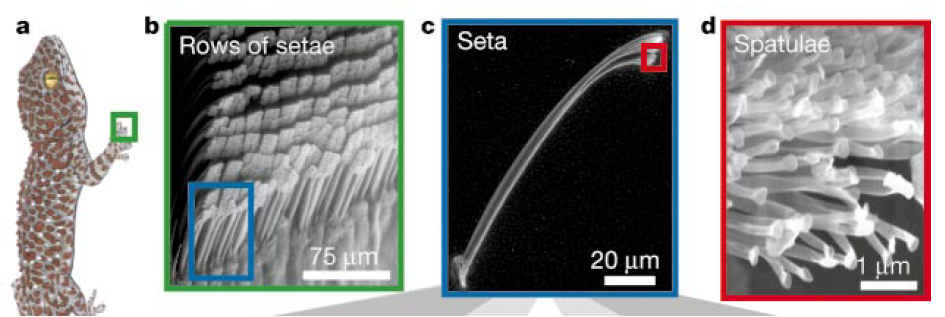Sometimes we get so used to our surroundings that we ignore the obvious. The common house lizard (gecko) has been a regular part of my life, much to my dislike. Yet, it was a while before I realized this obvious conundrum: the gecko runs on walls, or a particularly adventurous one might even walk upside down on the ceiling. This means that it can attach quite strongly to these surfaces, so as to not fall off. However, it also needs to detach easily to maintain quick mobility along the surface. How does it manage this gravity-defying attachment, followed by a quick detached movement?
A Gecko Grips, Not sticks, to Surfaces
The attachment mechanism of the gecko is by gripping, not sticking. The toe-pads of a gecko do not secrete any sticky glue-like material. In fact, they consist of millions of tiny hairs called setae. Each seta further branches into about 100-1000 spatulae at its end, resembling a make-up brush. The setae are normally curled up; they uncurl upon a slight sliding motion to attach to the wall surface. The attachment occurs through forces arising out of direct interaction between molecules, in this case, setae and wall. These interactive forces, called Van der Waals forces, get weaker over distance, which means that if the contact between the setae and wall is lost, the attachment force diminishes, and the toe can move forward.

Zoomed in images of gecko toe (a), showing rows of setae (b), a single seta (c), and spatulae (d) (Results from original publication)
Quantifying the Force Exerted by Gecko’s Toes
One research group directly measured the force exerted by an individual seta. This was done by carefully removing the seta from the animal and gluing it onto a platform. The spatulae-bearing ‘sticky’ end of the seta was allowed to interact with a spring-like surface termed cantilever. When the seta pulled with some force, the springy cantilever bent; when this force was no longer applied, the cantilever returned to its original position. The researchers noted that the seta starts exerting force after sliding for a short distance, then reaches its maximum attachment force of 200 microN. Considering that the animal has about 6 million setae, it should be able to lift an object of about 130 kg, IF all the setae engage at once.
Researchers Create Gecko-like Pads to Scale Walls
In reality, millions of setae are not engaged simultaneously in the gecko. In fact, the even distribution of forces, cleaning of the adhesive (gecko hairs are self-cleansing), and the right choice of material were few of the many challenges in making scaled-up artificial adhesives mimicking this mechanism. Several groups have nevertheless overcome some of these obstacles and succeeded in producing competent alternatives. A recent leap (or slide) was achieved in 2014, when a research group from Stanford demonstrated their ‘gecko-like’ pads to climb up a wall.
Although we have a long way to go, it’s heartening to know that Mission: Impossible-like wall scaling is not impossible after all.
Research groups working on gecko-like adhesives:

Interesting topic, nice article !
Made me curious for more 🙂
What is the curling and uncurling mechanism, for instance ?
Please keep on writing. Its good !
LikeLiked by 1 person
Thanks! 🙂 I will try to follow up on the curling-uncurling mechanism 😉
LikeLike
Interesting reading abt “gecko” the house lizard !! Amazing to learn such hi-tech mechanism at work even if seeing a lizard on a wall is not such pretty sight !!
A thing I hv observed is that if u cut the tail of the gecko apart fm its body — the tail still continues to move (or wiggle) !!!
Can u throw some light on this ?
Great reading & nice narrative
LikeLike
Thanks a lot. Its great that you enjoyed this article. And yes, lizards do detach their tails as a protective mechanism to confuse their predators. Maybe I will write sometime on the in-depth mechanism of tail detachment and regrowth 🙂
LikeLike
Yes the tail really wiggles if broken by force or by itself. Some tails might jump up to 2-3 cm even . Leopard gecko may also eat up their tail to recover from the energy loss that occurs during the detachment of tail but after ensuring that the predator is not around.
LikeLiked by 1 person
I found this blog and article from Biophysical society’s blog, and this is such a cool article! I love how the gecko is using van der Waals forces, something so common and it’s used to hold up the entire gecko! Anyway thanks and I’m going to go read more about this.
LikeLiked by 1 person
Thanks, glad you found out something new 🙂
LikeLike